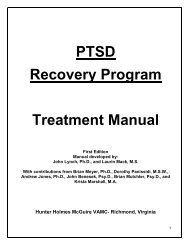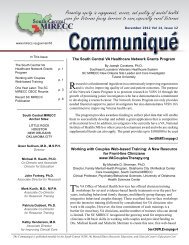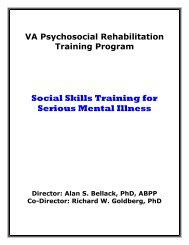Suicide Risk Assessment Package (VISN 3 MIRECC, US ...
Suicide Risk Assessment Package (VISN 3 MIRECC, US ...
Suicide Risk Assessment Package (VISN 3 MIRECC, US ...
Create successful ePaper yourself
Turn your PDF publications into a flip-book with our unique Google optimized e-Paper software.
This document may be used only with the permission of the <strong>VISN</strong> 3 <strong>Suicide</strong> Workgroup<br />
and the <strong>VISN</strong> 3 <strong>MIRECC</strong><br />
Interventions and Plan:<br />
(OVERVIEW:<br />
The goal of a suicide assessment is to then determine how best to prevent suicide as an<br />
outcome and as a guide to treatment. The fundamental guidelines for treating suicide are<br />
to address the environmental components, address the risk factors for suicide, and to help<br />
the patient weather the storm. For most patients, including the chronically suicidal,<br />
preventing suicide in the most immanent period usually allows the patient and<br />
professional some time to address the other issues. Weathering the storm involves<br />
providing adequate containment for the patient’s suicidal impulses. This may include<br />
hospitalization, but hospitalization is not the only form of containment, nor is it<br />
necessarily the best one. It is the last resort when it is the only possible way to keep the<br />
patient alive. Hospitalizing a suicidal patient can leave them leaving the hospital with the<br />
same problems that brought them in, sometimes even worsened by a hospital stay<br />
(financial, stigma, childcare, etc.), so hospitalization should be thought through in terms<br />
of the ability to address the problems that lead to the suicidal feelings.<br />
There are many other forms of containment. The simple arranging of continuing care, or<br />
a quicker appointment with the patient’s mental health provider, or an extra appointment<br />
or even phone call can serve as containment when the relationship with the provider is an<br />
important stabilizing force. In addition, if the patient has the means available for suicide,<br />
but is willing to work with the provider to remove the availability of those means, that<br />
can also serve as a form of containment. Sometimes it is necessary to have professionals<br />
in the patients living arrangements, families, or significant others involved in the<br />
prevention of suicide. This can also be part of working on some of the environmental<br />
problems that are feeding the suicidal urges.<br />
There is a subcategory of acute risk that is not specifically addressed and that is the<br />
category of immanent risk. Usually these are people with a high baseline increased risk,<br />
and a high degree of acute factors, with suicidal intent, and at least means available, if not<br />
a plan. These are patients where the confidence in the containment and existence of the<br />
mitigating factors should be high to allow the clinician to avoid hospitalization. Many of<br />
these patients have a history of previous attempts, and the personal risk factor section of<br />
the assessment becomes extremely important in determining if a patient needs<br />
hospitalization. Many patients with immanent risk will be hospitalized, but many will<br />
not.<br />
Hospitalization does not end the level of containment. For veterans, who in your clinical<br />
judgment, are at highest risk, hospitalization may not be enough containment, and they<br />
may require 1:1 observation or other special monitoring procedures.)<br />
[] Contact with family/social support made<br />
[] Containment<br />
[] Family agrees to observe patient<br />
[] Other social support (e.g. residence staff) agrees to observe patient<br />
[] Removal of means<br />
[] Firearms<br />
[] Other<br />
[] Initiate emergency hold:<br />
[] Admit to inpatient care<br />
[] Place patient on 1:1 observation






